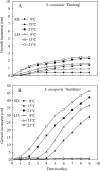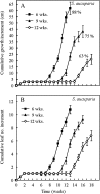Temperature rather than photoperiod controls growth cessation and dormancy in Sorbus species
- PMID: 21862485
- PMCID: PMC3223040
- DOI: 10.1093/jxb/err213
Temperature rather than photoperiod controls growth cessation and dormancy in Sorbus species
Abstract
Environmental regulation of growth and dormancy of four Sorbus genotypes was studied in controlled environments. Emphasis was placed on assessment of the presence and nature of the deficient photoperiodic dormancy regulation system that has previously been reported for some woody Rosaceae species. Two genotypes of Sorbus aucuparia L. maintained indeterminate growth for 8 weeks and 9 weeks at temperatures of 15 °C and 21 °C in both 20 h and 10 h photoperiods, while at 9 °C, in the same photoperiodic conditions, they immediately ceased growing. At the higher temperatures, initiation of new leaves (nodes) was unaffected by photoperiod, while internode elongation was significantly enhanced by long days (LD). However, even after prolonged exposure to 9 °C, most plants resumed growth when moved to high temperature and LD, indicating a shallow state of dormancy. Seedlings of Sorbus intermedia (J. F. Ehrh.) Pers. and micro-propagated plantlets of S. commixta Hedl. 'Dodong' were also unaffected by photoperiod during primary growth, but failed to elongate and gradually became dormant regardless of temperature and day-length conditions. However, after chilling and breaking of dormancy, the plants elongated vigorously but changed to a determinate mode of growth. Furthermore, a temperature of 9 °C was found to be fully effective for breaking dormancy in S. intermedia plants. It is concluded that deficient photoperiodic dormancy control seems widespread in the Rosaceae and that, in such plants, both dormancy induction and release is brought about by low temperature. The potential impacts of climate change on such trees are discussed.
Figures






Similar articles
-
Low temperature, but not photoperiod, controls growth cessation and dormancy induction and release in apple and pear.Tree Physiol. 2005 Jan;25(1):109-14. doi: 10.1093/treephys/25.1.109. Tree Physiol. 2005. PMID: 15519992
-
Photoperiodic control of dormancy in Sedum telephium and some other herbaceous perennial plants.Physiol Plant. 2001 Nov;113(3):332-337. doi: 10.1034/j.1399-3054.2001.1130305.x. Physiol Plant. 2001. PMID: 12060277
-
The joint influence of photoperiod and temperature during growth cessation and development of dormancy in white spruce (Picea glauca).Tree Physiol. 2016 Nov;36(11):1432-1448. doi: 10.1093/treephys/tpw061. Epub 2016 Jul 22. Tree Physiol. 2016. PMID: 27449791
-
Temperature-driven plasticity in growth cessation and dormancy development in deciduous woody plants: a working hypothesis suggesting how molecular and cellular function is affected by temperature during dormancy induction.Plant Mol Biol. 2010 May;73(1-2):49-65. doi: 10.1007/s11103-010-9610-y. Epub 2010 Feb 27. Plant Mol Biol. 2010. PMID: 20191309 Review.
-
Photoperiod- and temperature-mediated control of phenology in trees - a molecular perspective.New Phytol. 2017 Jan;213(2):511-524. doi: 10.1111/nph.14346. Epub 2016 Nov 30. New Phytol. 2017. PMID: 27901272 Review.
Cited by
-
Time-to-event analysis to evaluate dormancy status of single-bud cuttings: an example for grapevines.Plant Methods. 2018 Oct 27;14:94. doi: 10.1186/s13007-018-0361-0. eCollection 2018. Plant Methods. 2018. PMID: 30386412 Free PMC article.
-
Mapping of Candidate Genes Involved in Bud Dormancy and Flowering Time in Sweet Cherry (Prunus avium).PLoS One. 2015 Nov 20;10(11):e0143250. doi: 10.1371/journal.pone.0143250. eCollection 2015. PLoS One. 2015. PMID: 26587668 Free PMC article.
-
Willow phenological modelling at different altitudes in central Italy.Environ Monit Assess. 2020 Oct 30;192(11):737. doi: 10.1007/s10661-020-08702-7. Environ Monit Assess. 2020. PMID: 33128082 Free PMC article.
-
Persian Walnut (Juglans regia L.) Bud Dormancy Dynamics in Northern Patagonia, Argentina.Front Plant Sci. 2022 Feb 3;12:803878. doi: 10.3389/fpls.2021.803878. eCollection 2021. Front Plant Sci. 2022. PMID: 35185955 Free PMC article.
-
Elevational adaptation and plasticity in seedling phenology of temperate deciduous tree species.Oecologia. 2013 Mar;171(3):663-78. doi: 10.1007/s00442-012-2580-9. Epub 2013 Jan 11. Oecologia. 2013. PMID: 23306445
References
-
- Battey NH. Aspects of seasonality. Journal of Experimental Botany. 2000;51:1769–1780. - PubMed
-
- Böhlenius H, Huang T, Charbonnel-Campaa L, Brunner AM, Jansson S, Strauss SH, Nilsson O. CO/FT regulatory module controls timing of flowering and seasonal growth cessation in trees. Science. 2006;312:1040–1043. - PubMed
-
- Downs RJ, Borthwick HA. Effect of photoperiod on growth of trees. Botanical Gazette. 1956;117:310–326.
-
- Flemion F. Dwarf seedlings from non-after-ripened embryos of peach, apple and hawthorn. Contributions from the Boyce Thompson Institute. 1934;16:205–209.
-
- Garner WW, Allard HA. Further studies in photoperiodism, the response of the plant to relative length of day and night. Journal of Agricultural Research. 1923;23:871–920. - PubMed
MeSH terms
LinkOut - more resources
Full Text Sources
Research Materials

